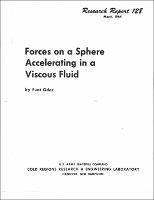Please use this identifier to cite or link to this item:
https://hdl.handle.net/11681/5918| Title: | Forces on a sphere accelerating in a viscous fluid |
| Authors: | Odar, Fuat |
| Keywords: | Hydrodynamics Frictional resistance Cold regions Snow Snow drift Snow transport |
| Publisher: | Cold Regions Research and Engineering Laboratory (U.S.) Engineer Research and Development Center (U.S.) |
| Series/Report no.: | Research report (Cold Regions Research and Engineering Laboratory (U.S.)) ; 128. |
| Description: | Research Report From the Introduction: Determination of the forces exerted by a fluid flow unsteady with respect to some of its boundaries has always been a big challenge in fluid mechanics. There are many ways that the motion of the fluid can be unsteady with respect to some of its boundaries. Either the boundaries or the fluid or both can accelerate. Examples of the first case are the motion of bombs or missiles through still air or water, acceleration of airships or submarines, and the deceleration of objects upon entering water or the atmosphere. The forces exerted by long waves on piles or on the bottom of a canal, and the friction due to unsteady flow in pipes fit in the second category. The last category may involve very complicated motions such as snow and sediment transport, wind-induced oscillations of tall chimneys and suspension bridges, and motion of piles, off-shore platforms, and anchored ships in waves. The investigation described herein was undertaken to solve problems concerned with drifting snow. Arctic buildings need to be shaped and arranged so that snowdrifts will not interfere seriously with their use. Like sediment transport in rivers, snow transport is too complicated by local geometry to permit mathematical analysis; so model studies are required. But, as will be illustrated subsequently, the usual similarity criteria cannot be met, and an attempt must be made to exert the proper total force on a model particle at each instant. Thus, the problem becomes one of determining the length, velocity, density and viscosity scale ratios that will, on an average, cause the model particles to follow paths similar to those of particles in nature. |
| Rights: | Approved for public release; distribution is unlimited. |
| URI: | http://hdl.handle.net/11681/5918 |
| Appears in Collections: | Research Report |
Files in This Item:
| File | Description | Size | Format | |
|---|---|---|---|---|
| CRREL-Research-Report-128.pdf | 1.81 MB | Adobe PDF |  View/Open |